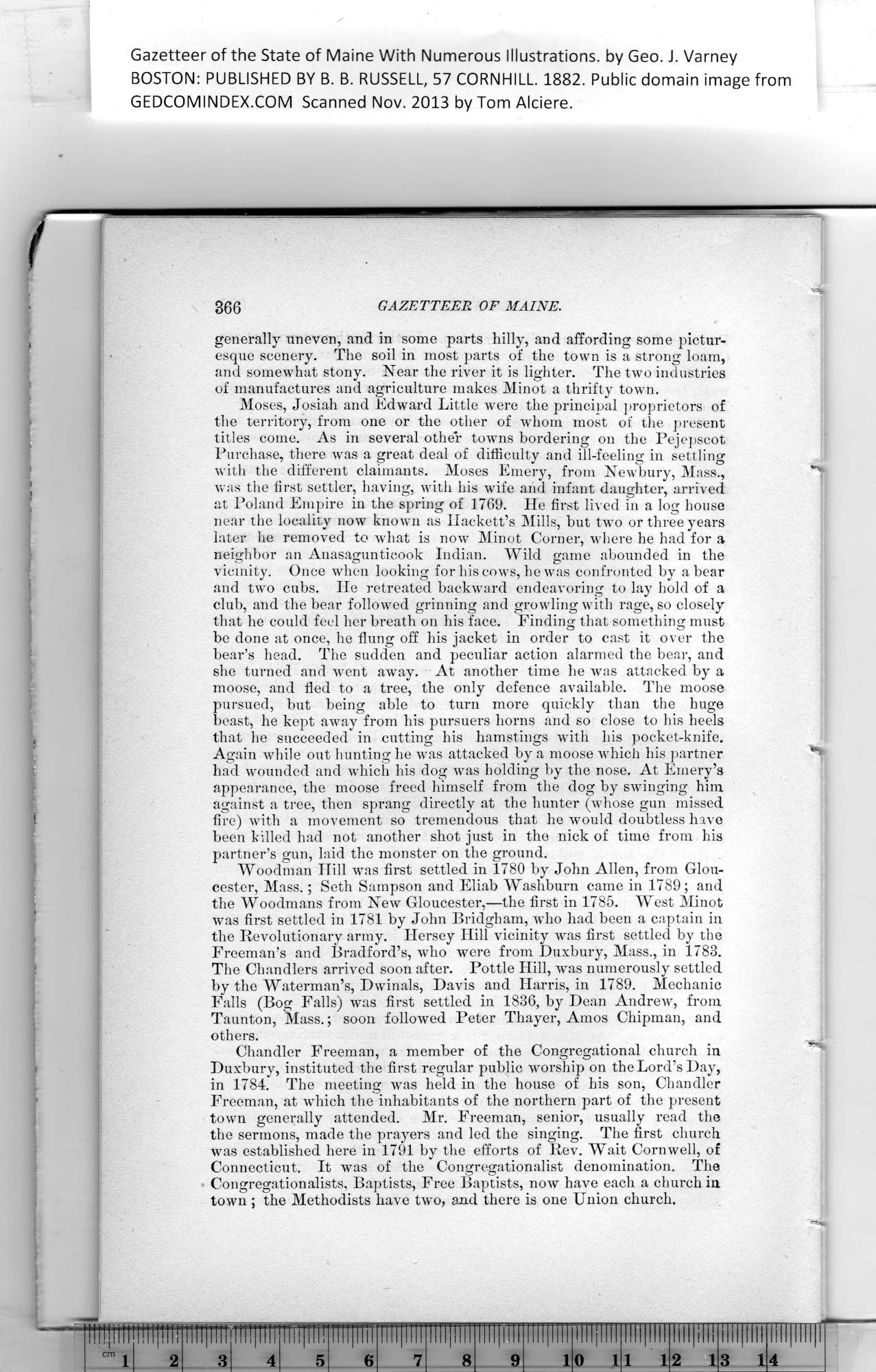|
Gazetteer of the State of Maine With Numerous Illustrations, by Geo. J. Varney
BOSTON: PUBLISHED BY B. B. RUSSELL, 57 CORNHILL. 1882. Public domain image from
366 GAZETTEER OF MAINE.
generally uneven, and in some parts hilly, and affording some pictur-
esque scenery. The soil in most parts of the town is a strong loam,
and somewhat stony. Near the river it is lighter. The two industries
of manufactures and agriculture makes Minot a thrifty town.
Moses, Josiah and Edward Little were the principal proprietors of
the territory, from one or the other of whom most of the present
titles come. As in several other towns bordering on the Pejepscot
Purchase, there was a great deal of difficulty and ill-feeling in settling
with the different claimants. Moses Emery, from Newbury, Mass.,
was the first settler, having, with his wife arid infant daughter, arrived
at Poland Empire in the spring of 1769. He first lived in a log house
near the locality now known as Ilackett’s Mills, but two or three years
later he removed to what is now Minot Corner, where he had for a
neighbor an Anasagunticook Indian. Wild game abounded in the
vicinity. Once when looking for his cows, he was confronted by a bear
and two cubs. He retreated backward endeavoring to lay hold of a
club, and the bear followed grinning and growling with rage, so closely
that he could feel her breath on his face. Finding that something must
be done at once, he flung off his jacket in order to cast it over tbe
bear’s head. The sudden and peculiar action alarmed the bear, and
she turned and went away. At another time he was attacked by a
moose, and fled to a tree, the only defence available. The moose
pursued, but being able to turn more quickly than the huge
beast, he kept away from his pursuers horns and so close to his heels
that he succeeded in cutting his hamstings with his pocket-knife.
Again while out hunting he was attacked by a moose which his partner v'-
had wounded and which his dog was holding by the nose. At Emery’s
appearance, the moose freed himself from the dog by swinging him
against a tree, then sprang directly at the hunter (whose gun missed
fire) with a movement so tremendous that he would doubtless have
been killed had not another shot just in the nick of time from his
partner’s gun, laid the monster on the ground.
Woodman Hill was first settled in 1780 by John Allen, from Glou-
cester, Mass.; Seth Sampson and Eliab Washburn came in 1789; and
the Woodmans from New Gloucester,—the first in 1785. West Minot
was first settled in 1781 by John Bridgham, who had been a captain in
the Revolutionary army. Hersey Hill vicinity was first settled by the
Freeman’s and Bradford’s, who were from Duxbury, Mass., in 1788.
The Chandlers arrived soon after. Pottle Hill, was numerously settled
by the Waterman’s, Dwinals, Davis and Harris, in 1789. Mechanic
Falls (Bog Falls) was first settled in 1836, by Dean Andrew, from
Taunton, Mass.; soon followed Peter Thayer, Amos Chipman, and
others.
Chandler Freeman, a member of the Congregational church in
Duxbury, instituted the first regular public worship on the Lord’s Day,
in 1784. The meeting was held in the house of his son, Chandler
Freeman, at which the inhabitants of the northern part of the present
town generally attended. Mr. Freeman, senior, usually read the
the sermons, made the prayers and led the singing. The first church
was established here in 1791 by the efforts of Rev. Wait Cornwell, of
Connecticut. It was of the Congregationalist denomination. The
Congregationalists, Baptists, Free Baptists, now have each a church in.
town ; the Methodists have two, and there is one Union church.
PREVIOUS PAGE ... NEXT PAGE
This page was written in HTML using a program written in Python 3.2
|
